CLASSICAL CUTS OF FISH
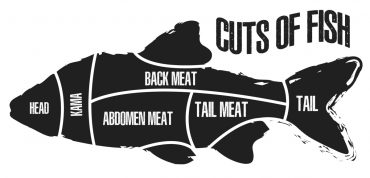
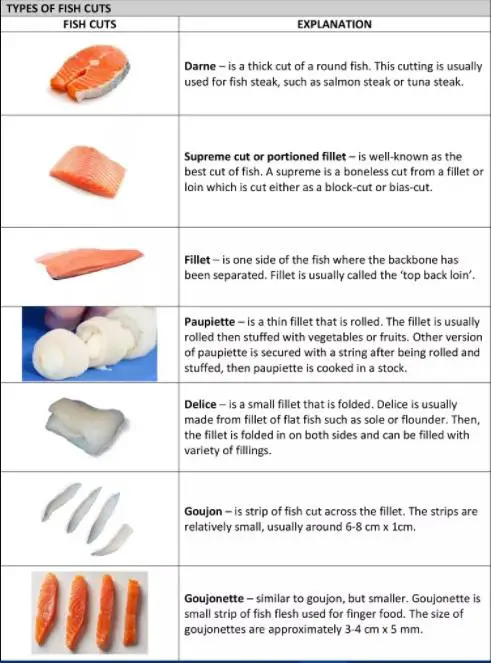
Fillet ( Le filet ) :

This cuts of fish is a side of a whole fish, cut and obtained after the removal of central bone. A round cuts of fish will yield two fillets and a flat fish will yield four fillets.
- A fillet is a cut of fish that removes the bones and is sliced parallel to the spine.
- A fillet is one of the more common cuts of fish because it is easy to eat.
There are two Types of Cuts of Fish Fillet:
The fish cuts name are given below
1. Fish fillet – skin on
2. Fish Fillet – skin off (without skin)
Supreme ( Le supreme ) :
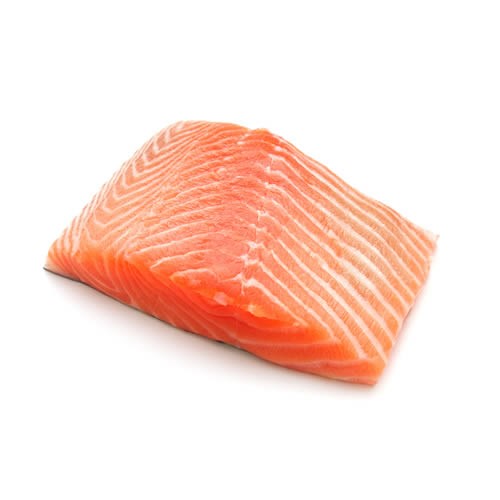
A type of fish cut on the slant taken from the large fish fillet. It is known as the best cut of fish. A supreme is a boneless cut from a fillet or lion which is cut either as a block cut or bais cut.
Delcie ( Le delice )
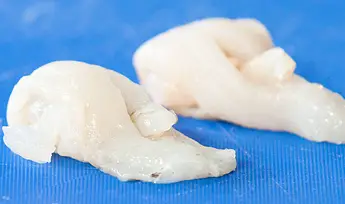
Small fillet of fish patted and neatly folded. Delicie cuts of fish is usually made from fillet of flat fish siuch as sole or flounder. the fillet is folded in on both sides and can be filled with variety of fillings.
Paupiette ( La paupiette ) :
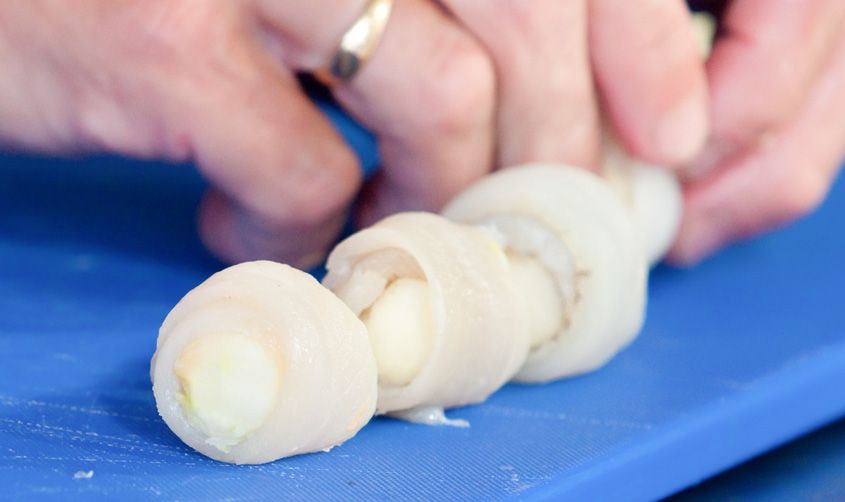
La paupiette fish cut
Small fillet of fish rolled in to cylindrical shape. Paupiettes are often filled with a fish stuffing and rolled. Small fillet of fish patted and neatly folded. A fillet is usually rolled then stuffed with vegetables or fruits. Other version of paupiette is secured with a string after being rolled and stuffed. then paupiette is cooked in a stock.
Thin strips ( Les goujons ) :
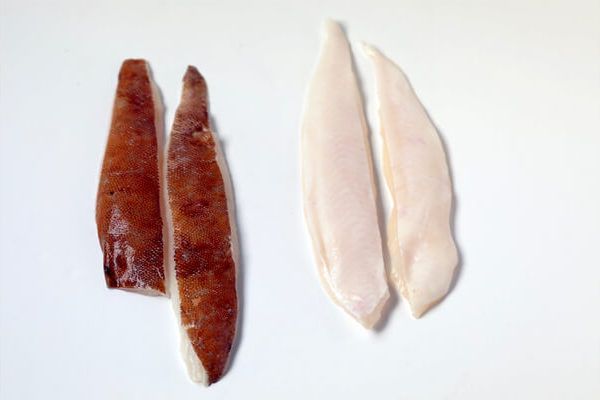
Goujons is a Fillet of fish cut into thin strips approximately 6 cm long with ¼ inch . thickness .
Tiny thin strips ( Les goujonettes ) :
Fillet is the cuts of fish made into very small strips as per goujons but cut into smaller version.
Steak of round fish ( Darne fish cut ) :

Darne fish cut is a cut of round fish on the bone. The cutting is usually used for fish steak, such as salmon steak or tuna steak.
Steak of flat fish ( Trocon ) :
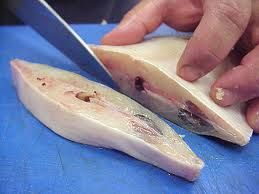
A cut of flat fish on the bone.
FISH AND SHELLFISH
Fish is readily available relatively cheap source of food which is high in proteins, vitamins and minerals. Its extremely perishable, so it must be cooked as quickly as possible after being caught and must be kept cold until it is cooked .There are hundred of species of fish : sea fish from the ocean and fresh water fish from lakes, rivers and streams.
CLASSIFICATION OF FISH
1. FISH
Round fish: These are the fish that have eyes on both sides of their body. They are found swimming near the surface of the water. E.g. cod, hake, haddock, whiting, eel, mackerel, salmon, trout.

Flat fish: These are the fish, which have eyes on the same side of their body. They are found at great depths at the bottom of the sea.E.g. Halibut, lemon sole, plaice, sole, turbot.
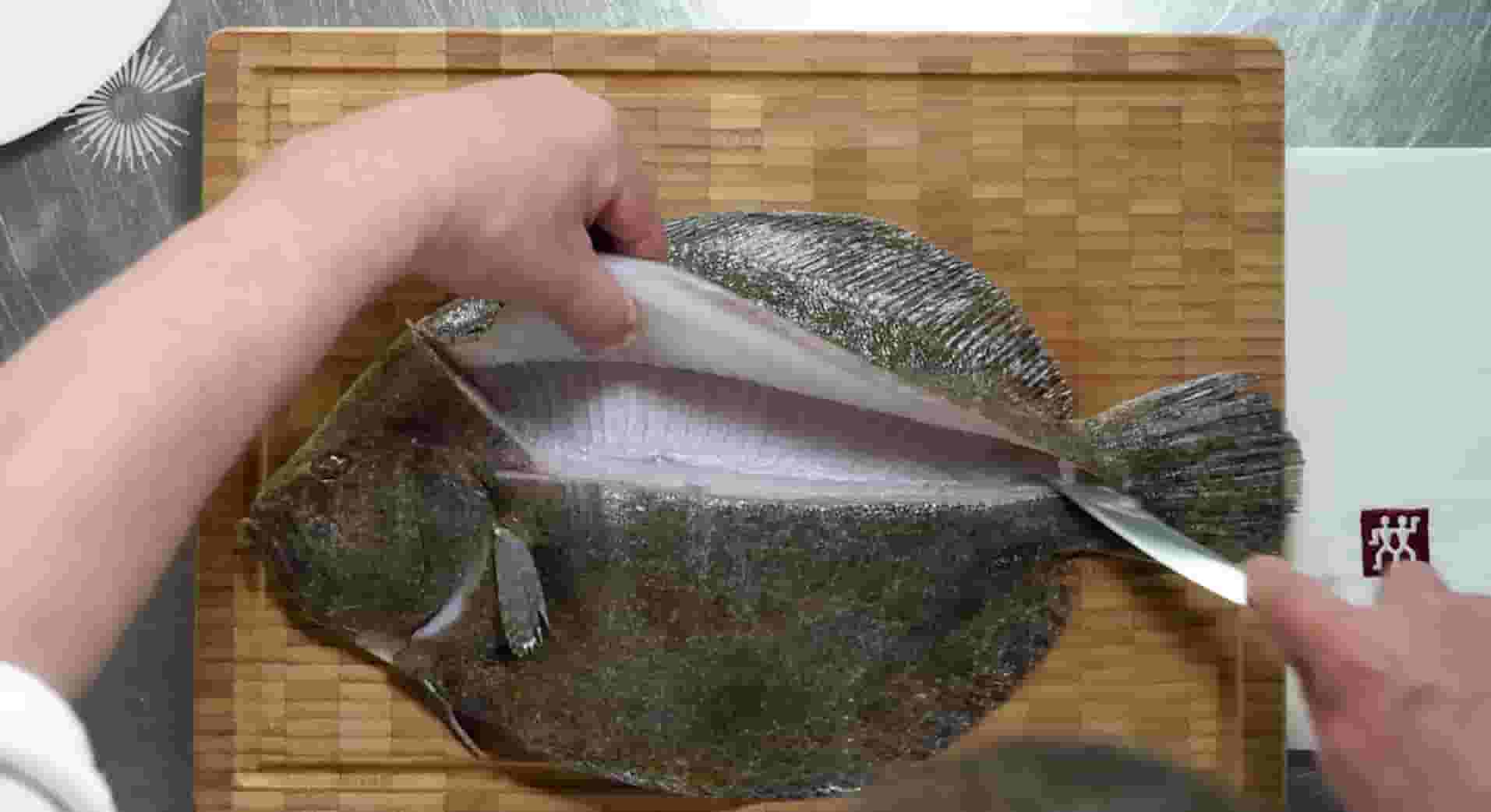
Fishes are also classified by their fat content
White fish: These are the fish that are low in fat content e.g. cod, hake, haddock, whiting, halibut, lemon sole, turbot.
Oily fish: These are the fish that are high in their fat content. E.g. eel, mackerel, salmon trout.
Fishes are also classified by their habitat:
River fish: River fish are More nourishing than seawater fish e.g. eel, lamprey, etc and are also more flavorful.
Sea fish: Less nourishing than fresh water fish
2. Selfish

Crustacea: Crab, crawfish, crayfish, lobster, prawns and shrimps.
Mollousca: Cockles, mussels, oysters, scallops.
3. CEPHALOPODS
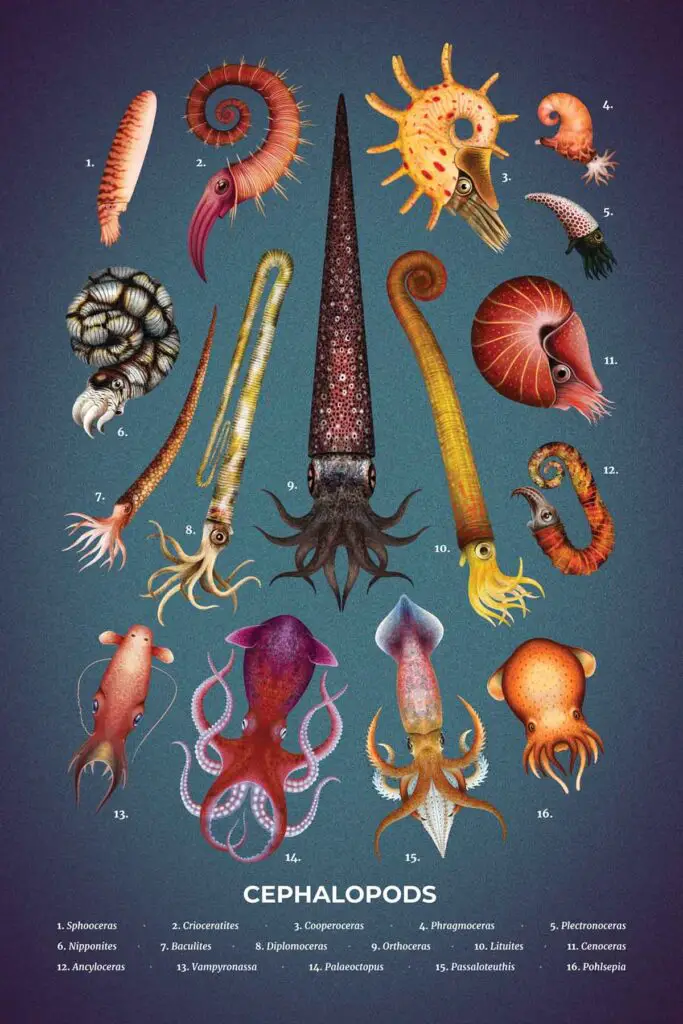
They include octopus and squids.
Octopus: octopus is firmly textured and has a marine flavour. It is generally sold fresh and free of its ink and beak. They are used in number of dishes including chowders and salads.
Squids:
It is one of the most widely available forms of seafood. They are suited to most of the cooking methods but the most popular are fried rings served in spicy sauces or stuffed.
SPOILAGE OF FISH – REASONS AND SIGNS:
Main bacterial spoilage is due to micrococcus, pseudomonas, corney bacteria, bacilli, achromo and flavo bactor.
These bacteria grow at higher pH i.e. more than 7; around a temperature of 15-20 deg. C.
Parasitic infections also cause early spoilage.
The bacterial growth can be eliminated by proper control of pH and temperature.
Spoilage also occurs in the fish when lactic acid content in the fish gets reduced due tostruggle and stress before death. TMA (trimethilamin) oxide is an important compound of marine fish. After death of the fish this compound is broken down due to oxidation and causes bad smell.
The other reasons for the spoilage are as follows:
Enzymes in dead fish because of microbes and chemicals bring about changes.
Faulty method of catching and handling
Personal hygiene.
Signs of spoilage of fish
• Such fish is liable to float in the water.
• Eyes are seen shrunken and collapsed.
• The gills are either gray or brown in color.
• Emit unpleasant and offensive odor.
• Scales are soft and easily rubbed off.
• Flesh is slimy and pits on pressure.
• Flesh is detached easily from bone structure. Unpleasant and offensive smell
from abdominal cavity.
• A pink color line along the back bone is the sign of decomposition.
ASSESMENT OF PERIOD OF FRESHNESS OF FISH
• Fish is fresh when the eyes are bright and bulging with red gills.
• In case the eyes are sunk to the level of eye brim, it may be considered 24 to 48 hours old.
• In case the eyes are sunk deep inside, it may be considered 48 hours or beyond.
Selection of fish
Fresh fish is ideal to procure . it depends upon the location, weather condition, high standards of hygienically maintained shops with proper infrastructure, and temperature control.
Following is the receiving standards for the receiving of the fish
In case of fish purchased whole:
- Eyes: Should be bright, full and not sunken, no slime or cloudiness.
- Gills: Should be bright red, no bacterial slime.
- Flesh: Should be firm, translucent and resilient so that when pressed the impression goes quickly. It should not be limp
- Scales: Should be flat, moist and plentiful.
- Skin: Should be covered with fresh sea slime, be smooth and moist with sheen and no abrasions or bruising and no discoloration.
- Smell: Pleasant, no ammonia or sourness
- Small fish when held horizontally on the palm, does not drop at the tail and
- remain rigid.
Purchasing points of prawns and lobster……
¾ Purchase alive with both claws attached to ensure freshness
¾ They should be heavy in proportion to their size.
¾ The coral of the hen lobster is necessary to give the required colour for the soups and
sauces.
¾ Hen lobsters are distinguished from the hen lobsters by a broader tail.
Purchasing points of crab…
¾ Buy alive to ensure freshness
¾ Ensure that both claws are attached
¾ They should be heavy in relation to their size Purchasing points of mussels…….
¾ The shells must be tightly closed to indicate that they are alive
¾ Mussels should be of good size
¾ There should not be an excessive number of barnacles attached
¾ Mussels should smell fresh
Structure of the Fish meat
All the fishes consist of nearly 75% of moisture and also the aluminous (egg whites) consistency varies little from fish to fish (18%). In the consistency of fat the variation is much wider; about 26% for the conger- eel family; 12% for salmon and salmon –trout; 9% for trout; 8.2% for shad and 6% for herring.
Fish flesh does not vary much from that of the land animals. Where the fish are at an advantage is in the contents of the phosphorated compounds and in the fact that fish especially the leaner ones, are much more easily digestible and so represent an excellent food for the sedentary and the sick.
Fish lack the connective tissue like land animals as they have no limbs and so the meat is lighter and flakier. Medium size fish are better than large fish, which may be coarse, small fish often lack flavour.
Fish is a useful source of animal protein as meat. The oily fish such as sardines,mackerels, herrings and salmon contain Vitamin A and Vitamin D in their flesh, white fish such as halibut and cod ,these vitamins are present in the liver.
The bones of sardines, whitebait, and tinned salmon when eaten provide the body with calcium and phosphorus. Fish is also a good source of magnesium, copper, iron and iodine. Since all fish contain protein, it is a good body building food and oily fish is useful for energy and as a protective food because of its vitamins.
Owing to its fat content oily fish are not so easily digestible as whit fish and is not suitable in cooking for invalids
Storage of fish
It is most important to maintain freshness and prevent staleness in the fish. In deep sea fishing operation, the aim is to catch maximum catch of edible fish in ideal condition.
Fish should not be subjected to more stress and stress after the catch.
Freshness depends upon temperature control, weather control and quantum of fish.
Immediately freezing at – 10 C is advisable while moving the seafood from deep-sea location to coast.
It is advisable to store fish at temperature ranging from –23 to –29 deg. C to conserve enzymes from destruction or keep fishes alive in tanks.
While receiving fish it should be checked whether the fish is being marketed below 3 deg C or not.
Fishes like tuna are stored at temperature more than – 20 deg C
Shellfish is normally stored in tanks alive after catch, and then it is subjected to processing.
Subjecting to temperature less than – 3deg C can enhance shelf life of certain fish It can be stored for more than three to six months. It is the case with shellfishes also.
Fresh fish should be stored in a fish box containing ice or in a separate refrigerator or part of a refrigerator used only for fish at a temperature of 1-2° C.
Preservation of Fish
There are several methods for the preservation of fish some of them are listed below
Freezing of Cut fish
Fresh fish (caught less than 4 hours beforehand): The whole fish should be gut, scaled, then washed, dried with absorbent paper, wrap in foil or plastic film and freeze in a tray for a proper preservation of fish.
Fish Slices: Freeze raw on a tray.
Small fish: Gut, dry and freeze raw in a tray.
All fish and shellfish should be stored on sealed plastic bags, preferably vacuum-packed.
All frozen fish should be thawed in a refrigerator for several hours before use. Do not thaw in water as it tends to damage the structure of the fish and does not taste as good.
The cooking tie for thawed fish will be a little longer than fresh fish. Once frozen fish has been thawed it should not be in any conditions be refrozen as this could prove as a major health hazard.
Cooking of fish
General prepreparation of fish before the actual cooking.
• Marinade the fish with salt ,lime juice and water for at least 20 minutes for
reducing the strong smell of the fish..This is known as first marrination.
• Wash the fish thoroughly under running water ,drain well and keep them dry.
• Make the final marrination liqueur with salt.pepper powder,Dijon mustard,white oil,white wine or white viniger and marinade the fish for another 20 minutes.
• Now process the fish as per the instructions given in the recipe.
Boiling
This method is suitable for whole fish such as salmon, turbot, trout and certain cuts of the fish on the bone such as salmon, cod, turbot, halibut, brill etc. In either case the fish should be completely immersed in the cooking liquid that can be water, water and milk, fish stock (for white fish) or a court bouillon for oily fish.
Whole fish are covered with a cold liquid and brought to boil; cut fish are usually placed in a simmering liquid.st
Poaching
This is suitable for small whole fish, cuts or fillets. Barely cover the fish with fish stock, cover with a buttered paper, and bring to boil and cook in the oven without allowing the liquid to boil. The cooking liquor is usually used for the sauce, which masks the fish.
Steaming
Any fish that can be poached or boiled may also be cooked by steaming which has a number of advantages.
¾ It is an easy method of cooking
¾ Cooking by stem can be rapid, thus conserving flavour, color and nutrients.
¾ It is particularly suitable for large-scale operations.
Fish to be steamed is prepared for cooking in the same way as per poaching. The sauce can be prepared separately, but the liquor from the steamed fish should be strained off, reduced and incorporated into the sauce.
Grilling
This method is suitable for small whole fish, cuts and fillets. The fish is passed through seasoned flour, brushed with oil and grilled on both sides. When fish is grilled under the salamander, grill bar marks may be made with a red- hot poker before cooking.
Grilling may also be done on a barbecue in which case the whole fish in cuts or in kebabs may be marinated for a short time, then the marinade is used to baste the fish whilst cooking. Whole fish can have sprigs of fresh herbs placed in the belly cavity and they can also be wrapped in oiled foil and cooked on a barbecue.
Shallow frying
This method is suitable for small whole fish, cuts and fillets. The fish is passed through seasoned flour, shallow fried on bit sides, and presentation side first in clarified fat in a frying pan. When the fish is placed on a serving dish or plate and is masked with nut brown butter, lemon juice, slice of lemon and chopped parsley it is termed as meuniere.
Deep frying
This method is suitable for small whole fish, cuts of fish and fillets. The fish can be coated by;
¾ Flour, egg and crumbed.
¾ Milk and flour
¾ Batter
The coating forms a surface to prevent penetration of the fat into the fish. Deep fried fish is served with a quarter of lemon and / or suitable sauce and fried parsley.
Many fish, whole, portioned or filleted may be baked in a oven. In order to retain the maximum moisture it is necessary to protect the fish from direct heat.
¾ Whole fish
¾ Completely cover in a thick coating of sea salt and bake.
¾ Wrap in pastry and bake
¾ Stuff with a duxelle based mixture of breadcrumbs, herbs, chopped onion, shallots or garlic.
¾ Portions of fish
¾ Place in a buttered or oiled dish and bake slowly, basting frequently.
In all case a suitable sauce can be offered with the fish.
Thick fish cuts of firm fish such as salmon, turbot, monkfish are suitable for roasting. The fish is usually portioned, lightly covered with oil and roasted in an oven in the usual way.
Finely sliced vegetables and springs of herbs can be put in the roasting tray and the fish when cooked can be removed from the tray and the pan deglazed with a suitable wine to form the base for an accompanying sauce.
Smoking It is the process thought to have developed from the age old method of preserving fish by wind- drying. Anxious to hasten a process entirely at the mercy of the elements , prehistoric man may have hung fish on poles over wood smoke or peat smoke , thus speeding up the dehydration process and preserving fish.
There are two ways of smoking fish and each one produces a completely different result.’Hot smoking’ produces cooked , ready to eat fish.’cold smoking’ takes place at a much lower temperature and it produces a smoky tasting fish which usually needs to be cooked before it is eaten.
Important Keywords In This Chapter: Cuts of Fish ,Classification Of Fish
fish cuts name



purple pharmacy mexico price list: mexican pharmacy – purple pharmacy mexico price list
india online pharmacy https://indiaph24.store/# world pharmacy india
indian pharmacy paypal
http://mexicoph24.life/# mexico pharmacy
https://mexicoph24.life/# purple pharmacy mexico price list
pharmacy website india http://indiaph24.store/# india pharmacy mail order
best india pharmacy
п»їbest mexican online pharmacies: Online Pharmacies in Mexico – mexico pharmacies prescription drugs
canada pharmacy world [url=https://canadaph24.pro/#]Licensed Canadian Pharmacy[/url] precription drugs from canada
http://indiaph24.store/# best online pharmacy india
tamoxifen for breast cancer prevention: tamoxifen and osteoporosis – tamoxifen hair loss
https://lisinopril.network/# lisinopril 5
cost for 20 mg lisinopril [url=http://lisinopril.network/#]lisinopril 5mg prices[/url] 20 mg lisinopril tablets
https://lisinopril.network/# lisinopril 250mg
buying cheap propecia online [url=https://finasteride.store/#]buy propecia price[/url] buying generic propecia price
antibiotics cipro: buy cipro online – buy generic ciprofloxacin
https://nolvadex.life/# liquid tamoxifen
how does tamoxifen work: nolvadex online – tamoxifen benefits
http://nolvadex.life/# tamoxifen citrate
http://finasteride.store/# get generic propecia pill
raloxifene vs tamoxifen [url=https://nolvadex.life/#]hysterectomy after breast cancer tamoxifen[/url] what happens when you stop taking tamoxifen
benefits of tamoxifen: tamoxifen and grapefruit – aromatase inhibitors tamoxifen
http://cytotec.club/# cytotec pills buy online
tamoxifen citrate [url=http://nolvadex.life/#]tamoxifen side effects forum[/url] tamoxifen and depression
buy cipro: ciprofloxacin over the counter – buy cipro online
https://lisinopril.network/# otc lisinopril
cost cheap propecia without dr prescription [url=https://finasteride.store/#]buying generic propecia price[/url] buy propecia pill
https://ciprofloxacin.tech/# cipro pharmacy
generic propecia without prescription: order generic propecia pill – buying propecia online
http://ciprofloxacin.tech/# ciprofloxacin over the counter
buying propecia without insurance [url=https://finasteride.store/#]home[/url] get cheap propecia without dr prescription
https://ciprofloxacin.tech/# ciprofloxacin
10 mg lisinopril cost [url=http://lisinopril.network/#]buy prinivil online[/url] cheap lisinopril
dcis tamoxifen: buy nolvadex online – tamoxifen men
http://ciprofloxacin.tech/# cipro 500mg best prices
http://finasteride.store/# order generic propecia for sale
https://lisinopril.network/# lisinopril 12.5 tablet
buy cytotec online: cytotec abortion pill – buy cytotec online
https://nolvadex.life/# tamoxifenworld
buy cipro online: ciprofloxacin order online – buy cipro online without prescription
http://finasteride.store/# get propecia no prescription
buy cytotec over the counter [url=https://cytotec.club/#]buy cytotec online[/url] cytotec buy online usa
get propecia without rx: cost of generic propecia without rx – cost of cheap propecia without a prescription
https://finasteride.store/# order propecia no prescription
buy cytotec in usa [url=https://cytotec.club/#]Cytotec 200mcg price[/url] cytotec abortion pill
Generic Tadalafil 20mg price: Cialis 20mg price in USA – Tadalafil Tablet
https://cenforce.pro/# cenforce for sale
Generic Levitra 20mg [url=http://levitrav.store/#]Generic Levitra 20mg[/url] Levitra 10 mg best price
https://cialist.pro/# Buy Tadalafil 20mg
Viagra online price: Buy Viagra online – viagra without prescription
Generic Tadalafil 20mg price [url=https://cialist.pro/#]Generic Tadalafil 20mg price[/url] п»їcialis generic
https://cenforce.pro/# cheapest cenforce
buy Viagra online: Buy Viagra online cheap – buy viagra here
https://levitrav.store/# Buy generic Levitra online
Levitra tablet price: Levitra 20mg price – Levitra online pharmacy
Cenforce 100mg tablets for sale: buy cenforce – Cenforce 100mg tablets for sale
buy cialis pill [url=https://cialist.pro/#]buy cialis online[/url] Generic Cialis without a doctor prescription
http://cenforce.pro/# Cenforce 150 mg online
Generic Viagra for sale [url=https://viagras.online/#]Buy Viagra online[/url] order viagra
Cheap generic Viagra online: Buy Viagra online cheap – best price for viagra 100mg
https://levitrav.store/# Generic Levitra 20mg
https://cialist.pro/# Buy Tadalafil 5mg
Vardenafil buy online [url=http://levitrav.store/#]levitrav.store[/url] Generic Levitra 20mg
viagra canada: Cheapest place to buy Viagra – Cheap generic Viagra online
cialis for sale: cialist.pro – cialis for sale
https://pharmcanada.shop/# pharmacy canadian superstore
canadian pharmacy no prescription needed: cheapest pharmacy – canadian pharmacy no prescription needed
mail order pharmacy no prescription: online pharmacy – canadian pharmacy no prescription
top 10 pharmacies in india: buy prescription drugs from india – indian pharmacies safe
reputable indian online pharmacy [url=http://pharmindia.online/#]cheapest online pharmacy india[/url] cheapest online pharmacy india
https://pharmcanada.shop/# buying from canadian pharmacies
mexican online pharmacies prescription drugs: mexico drug stores pharmacies – best online pharmacies in mexico
legitimate canadian mail order pharmacy [url=https://pharmcanada.shop/#]cheapest pharmacy canada[/url] canadian pharmacy near me
http://pharmmexico.online/# mexican pharmaceuticals online
top 10 online pharmacy in india: indian pharmacy paypal – cheapest online pharmacy india
online pharmacy canada no prescription [url=http://pharmnoprescription.icu/#]canadian mail order prescriptions[/url] buy medications without a prescription
https://pharmcanada.shop/# reputable canadian online pharmacy
northern pharmacy canada: canadian pharmacy no scripts – canadian pharmacy online
pharmacy no prescription required: online pharmacy – online pharmacy prescription
http://pharmworld.store/# no prescription needed pharmacy
http://pharmcanada.shop/# canadian world pharmacy